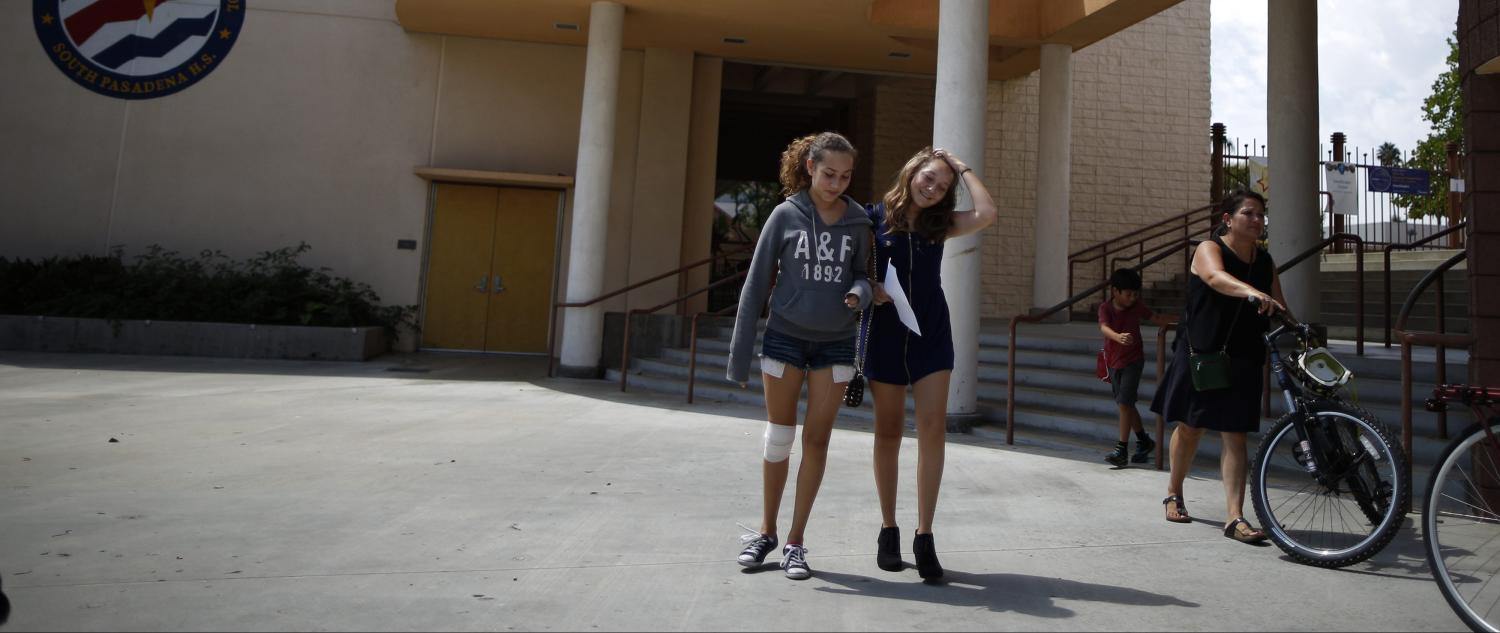A recent report by the U.S. Department of Education (USED) identifies “chronic absenteeism” as a hidden educational crisis.1 In 2013-14, roughly 14 percent of students nationwide were chronically absent—defined as missing 10 percent or more of school days, excused or unexcused, which in most states would correspond to about 18 days of school missed each year.2 In some cities, that rate is considerably higher, with Detroit topping the list at 57.3 percent of students chronically absent.3
Absenteeism is not a new concern, however. Educators and local officials were focused on this issue as early as the late 19th century—a quarter of the juveniles jailed at the Chicago House of Correction in 1898 were there for truancy.4 From Tom Sawyer to Ferris Bueller, truancy has been a staple of popular culture in the U.S.
And yet, despite considerable effort on the part of schools, communities, and states over the past 20 years, little progress has been made.5 It is worth reviewing what we know about the causes, consequences, and potential solutions for chronic absenteeism.
The consequences of chronic absenteeism
Chronic absenteeism is associated with a host of adverse academic outcomes. A 2008 study of graduation patterns in Chicago Public Schools, for example, found that the number of days students were absent in eighth grade was eight times more predictive of freshman year course failure than eighth grade test scores.6 The same study found that freshman year absences were nearly as predictive of graduation rates as grade point average (GPA) and course failures, two more commonly used metrics for identifying students at risk of not graduating.7 Similarly, a study of Baltimore City Public Schools found that chronic absenteeism was the strongest sixth grade predictor of not graduating high school.8
For younger students, research has shown that chronic absenteeism in kindergarten is associated with lower achievement in reading and math in later grades, even when controlling for a child’s family income, race, disability status, attitudes toward school, socioemotional development, age at kindergarten entry, type of kindergarten program, and preschool experience.9 Chronic absenteeism has also been linked to poor socioemotional outcomes, even after controlling for a rich set of student factors including lagged socioemotional measures.10
It is worth noting that the existing research can’t definitively say that chronic absenteeism directly causes students to have worse academic outcomes. It may be the case, for example, that poor academic performance causes a student to choose to miss school, rather than the reverse. Or there may be a third confounding factor that causes both, such as lack of sleep that causes a student both to miss his bus in the morning, hence leading to low attendance, and to struggle to focus for exams, hence leading to low achievement. Nonetheless, the intuitive connection between school attendance and learning—coupled with the strong patterns of association between absenteeism and performance—suggests that chronic absenteeism is a problem worth addressing.
Patterns of chronic absenteeism by student demographics
While rates of chronic absenteeism are surprisingly high overall, there are some important differences across student demographics. According to statistics compiled by the USED (Figure 1), black students are significantly more likely to be chronically absent than their white peers, while Asian students are the least likely to be chronically absent.11 English language learners (LEP) are 1.2 times less likely to be chronically absent than peers, while students with disabilities (IDEA) are nearly 1.5 times more likely to be chronically absent than peers.12
While national data do not allow one to examine chronic absenteeism by socioeconomic status, existing research finds that chronic absenteeism is significantly more common among economically disadvantaged students.13 For example, a national study of kindergartners found that 21 percent of poor children were chronically absent compared to only 8 percent of their non-poor peers.13
Other research finds an interesting pattern across grades—namely, chronic absenteeism is high in kindergarten, drops to the lowest rates around fourth and fifth grade, and then climbs steadily through middle and high school to peak in 12th grade.14
Reasons for chronic absenteeism
Researchers categorize the underlying causes of truancy into four groups: (i) student-specific factors, (ii) family-specific factors, (iii) school-specific factors, and (iv) community-specific factors (Table 1). As one might expect, the importance of various factors depends a great deal on the student’s age and social context. Kindergarten absenteeism is most strongly related to family factors—e.g., children whose parents suffer from substance abuse, or whose work schedules makes it difficult for them to get their children out the door each morning.
Teenage truancy, on the other hand, is more frequently associated with student- or school-factors, such as fear of bullying or disengagement with school. For example, in a recent Evidence Speaks post, Jing Liu and Susanna Loeb reported that high school teachers have differential effects on unexcused class absences—that is, when students miss only part of the school day—highlighting how the academic environment can influence school attendance.15
| Table 1: Factors related to absenteeism | |
| Student-specific | Teenage motherhood, low academic performance and repeating grades, lack of caring relationships with adults, negative peer influence, bullying |
| Family-specific | Low family income, low parent involvement, unstable housing, at-home responsibilities, stressful family events conflicting home and school priorities, language differences |
| School-specific | Poor conditions or lack of school facilities, low-quality teachers, teacher shortages, poor student-teacher interactions, geographic access to school, less challenging courses and student boredom |
| Community-specific | Availability of job opportunities that do not require formal schooling, unsafe neighborhoods, low compulsory education requirements, lack of social and education support services |
| Source: REL Pacific, Review of research on student nonenrollment and chronic absenteeism | |
What do we know about reducing chronic absenteeism?
Schools, communities, and states have been working for years to reduce truancy through implementation of myriad interventions. Some are based in schools and operated by teachers or counselors; others are court-based, administered by judges, social workers or other court staff; yet others are community-based, and organized by local non-profits. Some programs work with families; others focus primarily on students themselves; and a few attempt to address structural school factors.
There are hundreds of studies on programs designed to increase school attendance. Unfortunately, very few meet even a minimum standard of rigor. A 2012 meta-analysis conducted by the Campbell Collaboration identified 391 studies of truancy interventions, only 28 of which provided any plausible basis for determining that the program was effective.16 The authors find that many of these interventions were effective, on average leading to a reduction in the number of days absent by 4.69 days.17 However, for the most part, these interventions studied were small, locally-developed programs, so it is not known whether these approaches can be replicated at scale.
A handful of large, well-known interventions designed to support at-risk students target school attendance as a key intermediate outcome. These programs share several common features, including an early warning system to identify at-risk students and individualized support for such students. Interventions are typically provided within a case management model, where school personnel or program staff work with students, and often their families, on a range of issues. The verdict on these programs is mixed, however.
One such program, Check & Connect, showed some promise in two small RCTs that studied the intervention for students with disabilities.18 The program involved monitoring student attendance, suspensions, course grades, and credits to provide individualized attention to at-risk students, and basic interventions include conversations between a monitor and the student about topics such as progress in school and how to resolve conflicts and cope with challenges. However, a more recent quasi-experimental study on a broader population finds no effects.19
On the other hand, interim results from a recent RCT of the Early Warning Intervention and Monitoring System (EWIMS) indicate that the program has reduced chronic absenteeism rates from 14 to 10 percent.20 EWIMS is primarily a monitoring system, rather than a single intervention, but includes highly detailed and structured guidance for schools, along with a tool to help monitor student attendance and academic performance. Interventions for students found to be off-track are determined and implemented by school or district staff.
There is also some non-experimental evidence that an initiative in New York City under Mayor Bloomberg—which brought together a dozen city agencies to institute a pilot program that had many features considered best practices in truancy reduction—reduced absenteeism rates among poor children in participating schools.21 The program included improved use of data to identify students at risk of chronic absenteeism, student mentors, principal-led school partnership meetings, connections to community resources, an awareness campaign, and attendance incentives.
States and localities, for their part, have enacted a variety of measures aimed at curbing truancy, including laws that mandate steep fines and even jail time for juvenile truants and their parents.22 Many such laws have gained notoriety for the draconian consequences they impose. Several years ago, for example, a Houston-area judge jailed a 17-year-old honor-roll student who had missed school because she was working two jobs to support her siblings after her parents divorced and moved out of state.23 There is no evidence to suggest the these laws as a whole have reduced chronic absenteeism, and critics point out that they impose harsh and undue burdens on poor families and students with disabilities.24
On the other hand, recent evidence suggests that “No Pass, No Drive” laws—which make obtaining (or keeping) a driver’s license conditional on school performance—reduce chronic absenteeism among high school students.25
Several recent studies have tested low-cost, information-based interventions to improve student attendance. In one such program, parents received a postcard about the importance of attendance. One random-assignment evaluation found that sending parents that single postcard reminder about the importance of attending school increased attendance by 2.4 percent.26 A similar intervention reduced absences by about 10 percent.27 Text messaging to parents, which has gained popularity recently as a low-cost intervention, has been shown to improve attendance by 17 percent.28
Where to go from here?
The first step is for states and districts to collect high quality data. The Every Student Succeeds Act (ESSA) requires states to report data on chronic absenteeism, but there is still much work to be done at the school and district level to ensure the quality and consistency of such data.29 One way to accomplish this would be for states to adopt chronic absenteeism as the fifth accountability measure in statewide ESSA systems, as recommended in a recent Hamilton Project report.30
The next step is for schools to use this data in a strategic and ongoing way to identify truant students, and then monitor efforts to improve their attendance. The evidence suggests that a variety of different types of programs can be successful. As with all programs, the quality of implementation seems critical. In the case of truancy prevention, implementation is particularly challenging because staff need to identify and respond to a variety of different factors underlying the absenteeism—from parental substance abuse to school bullying to transportation challenges.
While some broad policies such as No Pass, No Drive and some low-intensity interventions have produced small improvements, it is likely that substantial improvement will require more substantial investments. Fortunately, because attendance is a “high-frequency” outcome, it affords educators and researchers a perfect laboratory to pilot and test a variety of strategies in a relatively short period of time. Some recently developed interventions seem promising. We hope that the renewed attention on chronic absenteeism by policymakers will be accompanied by greater collaboration between educators and researchers to develop and assess strategies for keeping kids in school.
The authors were not paid by any entity outside of Brookings to write this particular article and did not receive financial support from or serve in a leadership position with any entity whose political or financial interests could be affected by this article.
-
Footnotes
- US Department of Education. Chronic absenteeism in the nation’s schools. From: https://www2.ed.gov/datastory/chronicabsenteeism.html
- There is not a single, agreed-upon definition of the chronic absenteeism. It is commonly defined as missing 10 percent or more of a school year. When the US Department of Education (USED) instituted reporting of chronic absenteeism in the 2013-2014 Civil Rights Data Collection (CRDC), however, the requested measure was the proportion of students who were absent 15 or more days of the school year. All definitions of chronic absenteeism consider both unexcused and excused absences, due to the commonsense assumption that missed learning impacts students regardless of the reason for the absence.
- Author’s calculations based on the 2013-2014 Civil Rights Data Collection (CRDC), available here: https://www2.ed.gov/about/offices/list/ocr/docs/crdc-2013-14.html
- https://www.themarshallproject.org/2015/03/06/inexcusable-absences#.mtO3pAORA
- Maynard, B., McCrea, K., Pigott, T., & Kelly, M. 2012. Indicated Truancy Interventions: Effects on School Attendance among Chronic Truant Students. Campbell Systematic Reviews, 2012:10.
- Allensworth, E. & J. Easton, 2008. What Matters for Staying On-Track and Graduating in Chicago Public High Schools: A Close Look at Course Grades, Failures, and Attendance in the Freshman Year. Consortium on Chicago School Research, July 2008.
- Allensworth, E. & J. Easton, 2008. What Matters for Staying On-Track and Graduating in Chicago Public High Schools: A Close Look at Course Grades, Failures, and Attendance in the Freshman Year. Consortium on Chicago School Research, July 2008.
- Baltimore Education Research Consortium. 2011. Destination Graduation: Sixth Grade Early Warning Indicators for Baltimore City Schools: Their Prevalence and Impact.
- Romero, M. & Lee, Y. 2007. A National Portrait of Chronic Absenteeism in the Early Grades. New York, NY: National Center for Children in Poverty: The Mailman School of Public Health at Columbia.
- Gottfried, M. 2014. Chronic Absenteeism and Its Effects on Students’ Academic and Socioemotional Outcomes. Journal of Education for Students Placed at Risk (JESPAR), 19:2, 53-75.
- Author’s calculations based on the 2013-2014 Civil Rights Data Collection (CRDC), available here: https://www2.ed.gov/about/offices/list/ocr/docs/crdc-2013-14.html
- US Department of Education. Chronic absenteeism in the nation’s schools. From: https://www2.ed.gov/datastory/chronicabsenteeism.html
- Romero, M. & Lee, Y. 2008. The Influence of Maternal and Family Risk on Chronic Absenteeism in Early Schooling. New York, NY: National Center for Children in Poverty: The Mailman School of Public Health at Columbia.
- Balfanz, R. & Byrnes, V. 2012. The Importance of Being in School: A Report on Absenteeism in the Nation’s Public Schools. Everyone Graduates Center, Johns Hopkins University School of Education.
- https://www.brookings.edu/research/going-to-school-is-optional-schools-need-to-engage-students-to-increase-their-lifetime-opportunities/
- Maynard, B., McCrea, K., Pigott, T., & Kelly, M. 2012. Indicated Truancy Interventions: Effects on School Attendance among Chronic Truant Students. Campbell Systematic Reviews, 2012:10.
- The study sample included interventions such as student counseling, behavioral interventions, family therapy, interdisciplinary team meetings, criminal prosecution, case management. The authors found that intervention effects did not vary significantly by program type, though the number of studies of each type was small enough that it would have been difficult to differentiate between program effects.
- U.S. Department of Education, Institute of Education Sciences, What Works Clearinghouse. 2015. Dropout Prevention intervention report: Check & Connect. Retrieved from http://whatworks.ed.gov
- https://www.air.org/sites/default/files/downloads/report/Mentoring-for-at-risk-high-school-students-check-%26-connect-February-2017.pdf
- https://ies.ed.gov/ncee/edlabs/regions/midwest/pdf/REL_2017272.pdf
- Poor students in pilot schools were 15 percent less likely to be chronically absent, relative to similar students at comparison schools. Balfanz, R. & Byrnes, V. 2014. Meeting the Challenge of Combating Chronic Absenteeism. Everyone Graduates Center, Johns Hopkins University School of Education.
- See, for example, the following articles: https://www.theatlantic.com/national/archive/2012/09/the-truancy-trap/261937/ and https://newrepublic.com/article/121186/truancy-laws-unfairly-attack-poor-children-and-parents.
- Horswell, Cindy. “Charges dropped against honor student jailed for truancy.” The Houston Chronicle, May 31, 2012.
- A 2011 study in Washington State found that while truants who received court petitions showed a modest short-term increase in attendance, they fared no better in the long-run than other truant students who did not experience the judicial intervention. See: https://www.courts.wa.gov/subsite/wsccr/docs/TruancyEvalReport.pdf
- Rashmi Barua and Marian Vidal-Fernandez (2014). “No Pass No Drive: Education and Allocation of Time,” The Journal of Human Capital, 8 (4): 399-431.
- https://ies.ed.gov/ncee/edlabs/regions/midatlantic/pdf/REL_2017252.pdf
- Rogers, T. & Feller, S. 2014. Intervening through Influential Third Parties: Reducing Student Absences at Scale via Parents. http://www.attendanceworks.org/wordpress/wp-content/uploads/2014/12/Todd-Rogers-Avi-F.-nfluential_third_parties.pdf
- Bergman, P. & Chan, E. 2017. “Leveraging Parents through Technology: The Impact of High-Frequency Information on Student Achievement.”
- In Michigan, for example, school officials have expressed concern about attendance reporting standards. Some schools count all students present until a teacher submits attendance, while others consider all students to be absent until attendance is submitted. In addition, there is no consistent definition of how much of a school day a student must miss before being considered absent for the full day, or how tardy a student may be before being counted as absent for a class period.
- http://www.hamiltonproject.org/assets/files/lessons_school_accountability_essa.pdf





